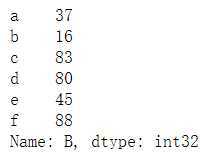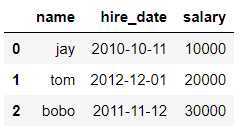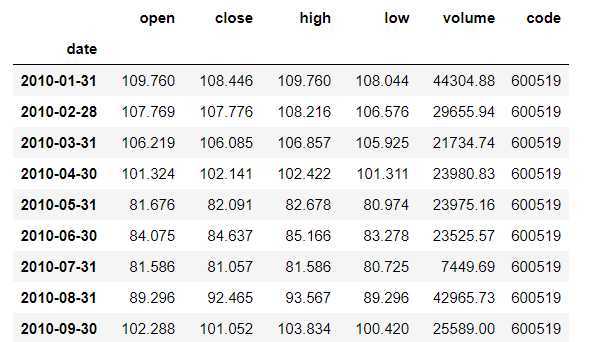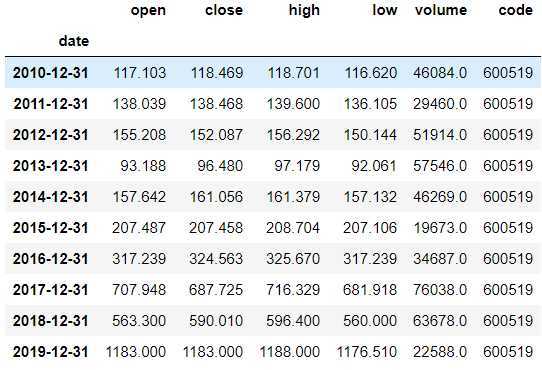numpy模块、pandas模块.基本操作、股票案例
数据分析三剑客
- numpy
- pandas(重点)
- matplotlib
重点:
- numpy数组的创建
- numpy索引和切片
- 级联
- 变形
- 矩阵的乘法和转置
- 常见的聚合函数+统计
numpy的创建
- 使用np.array()创建
- 使用plt创建
- 使用np的routines函数创建
使用array()创建一个一维数组
import numpy as np
np.array([1,2,3,4,5])
使用array()创建一个多维数组
np.array([[1,2,3],[4,5,6]])
数组和列表的区别是什么?
- 数组中存储的数据元素类型必须是统一类型
- 优先级:
- 字符串 > 浮点型 > 整数
IN np.array([[1,2,3],[4.4,5,6]])
OUT array([[1. , 2. , 3. ], [4.4, 5. , 6. ]]) --------------------------------->浮点型
IN np.array([[1,‘two‘,3],[4.4,5,6]])
out array([[‘1‘, ‘two‘, ‘3‘],
[‘4.4‘, ‘5‘, ‘6‘]], dtype=‘<U21‘)------------------->字符型
将外部的一张图片读取加载到numpy数组中,然后尝试改变数组元素的数值查看对原始图片的影响
import matplotlib.pyplot as plt
#imread可以返回一个numpy数组
img_arr = plt.imread(‘./滑稽.jpg‘)
#将返回的数组的数据进行图像的展示
plt.imshow(img_arr)
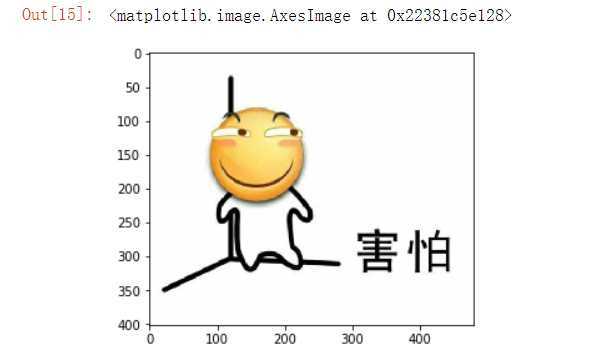
plt.imshow(img_arr - 100) 图片转换的np数组中的每个元素都-100
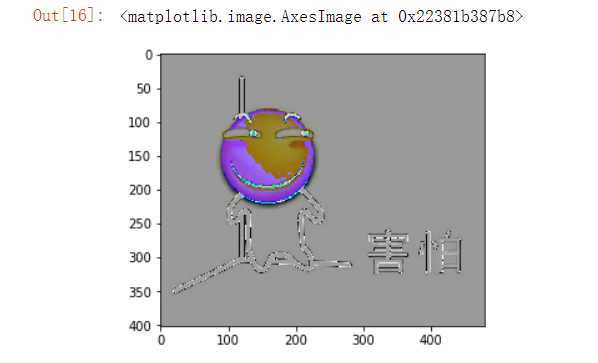
- zero()
- ones()
- linespace()
- arange()
- random系列
np.ones(shape=(3,4)) shape 形状 创建一个三行,四列的数组 zero() 和ones() 用法一样
array([[1., 1., 1., 1.],
[1., 1., 1., 1.],
[1., 1., 1., 1.]])
np.linspace(0,50,num=10) #返回一维形式的等差数列 0 50 范围 num 返回元素个数
numpy的常用属性
- shape
- ndim
- size
- dtype
img_arr.shape #返回数组形状
(402, 480, 3)
img_arr.ndim #维度
3
img_arr.size #返回数组元素总个数
578880
img_arr.dtype #数组元素的数据类型
dtype(‘uint8‘)
type(img_arr) #数组的类型
numpy.ndarray
numpy的数据类型
- array(dtype=?):可以设定数据类型
- arr.dtype = ‘?‘:可以修改数据类型

arr = np.array([1,2,3],dtype=‘float32‘) arr
array([1., 2., 3.], dtype=float32)
#修改arr元素的数据类型
arr.astype(‘int8‘)
array([1, 2, 3], dtype=int8)
numpy的索引和切片操作(重点)
- 索引操作和列表同理
arr = np.random.randint(0,100,size=(5,6))
arr
array([[14, 89, 71, 96, 1, 94],
[30, 98, 10, 64, 71, 54],
[ 4, 80, 6, 27, 88, 3],
[83, 75, 99, 24, 57, 37],
[98, 24, 57, 42, 20, 21]])
arr[1][3]
64
切片操作
- 切出前两列数据
- 切出前两行数据
- 切出前两行的前两列的数据
- 数组数据翻转
- 练习:将一张图片上下左右进行翻转操作
- 练习:将图片进行指定区域的裁剪
#切出数组的前两行的数据 arr[0:2]
#切出数组的前两列
arr[:,0:2] #逗号前为行,逗号后为列
#切出前两行的前两列
arr[0:2,0:2]
array([[14, 89],
[30, 98]])
#将数组进行倒置
arr[::-1]
array([[98, 24, 57, 42, 20, 21],
[83, 75, 99, 24, 57, 37],
[ 4, 80, 6, 27, 88, 3],
[30, 98, 10, 64, 71, 54],
[14, 89, 71, 96, 1, 94]])
#将数组进列倒置
arr[:,::-1]
array([[94, 1, 96, 71, 89, 14],
[54, 71, 64, 10, 98, 30],
[ 3, 88, 27, 6, 80, 4],
[37, 57, 24, 99, 75, 83],
[21, 20, 42, 57, 24, 98]])
#将数组进行和列都倒置
arr[::-1,::-1]
array([[21, 20, 42, 57, 24, 98],
[37, 57, 24, 99, 75, 83],
[ 3, 88, 27, 6, 80, 4],
[54, 71, 64, 10, 98, 30],
[94, 1, 96, 71, 89, 14]])
img_arr.shape
(402, 480, 3) #402 480 是像素 也是就行和列 3控制的是颜色
#将图片进行左右翻转
plt.imshow(img_arr[:,::-1,:])
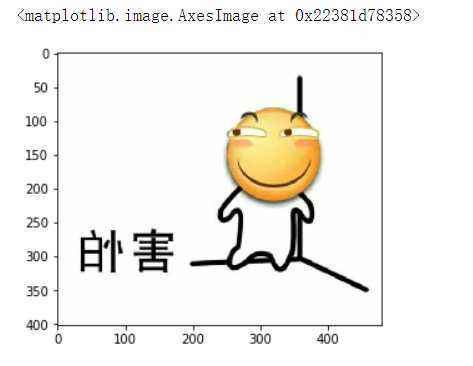
plt.imshow(img_arr[::-1]) #上下倒置
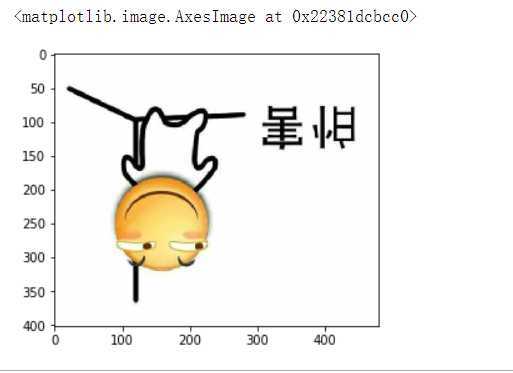
plt.imshow(img_arr[::-1,::-1,::-1]) #上下左右 颜色都倒置
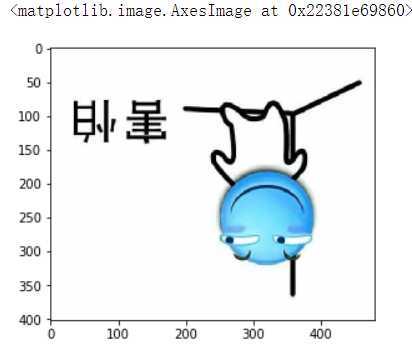
#图片的裁剪:将脸部数据裁剪下来
plt.imshow(img_arr[80:220,90:230,:])

变形reshape
- 注意:变形前和变形后数组的容量不可以发生变化
arr
array([[97, 52, 0, 10, 49, 90], [43, 96, 1, 51, 17, 12], [22, 9, 26, 78, 24, 59], [86, 85, 69, 17, 95, 37], [61, 61, 79, 19, 82, 98]])
arr.shape
(5, 6)
#将二维数组变形成一维数组
arr_1 = arr.reshape((30,)) #arr 是五行六列 30个元素 变形前和变形后数组的容量不可以发生变化
array([97, 52, 0, 10, 49, 90, 43, 96, 1, 51, 17, 12, 22, 9, 26, 78, 24,
59, 86, 85, 69, 17, 95, 37, 61, 61, 79, 19, 82, 98])
#将一维变多维
arr_1.reshape((6,5))
array([[14, 89, 71, 96, 1],
[94, 30, 98, 10, 64],
[71, 54, 4, 80, 6],
[27, 88, 3, 83, 75],
[99, 24, 57, 37, 98],
[24, 57, 42, 20, 21]])
arr_1.reshape((-1,5)) #-1 表示自动匹配
array([[14, 89, 71, 96, 1],
[94, 30, 98, 10, 64],
[71, 54, 4, 80, 6],
[27, 88, 3, 83, 75],
[99, 24, 57, 37, 98],
[24, 57, 42, 20, 21]])
级联操作
- 将多个numpy数组进行横向或者纵向的拼接
- axis轴向的理解
- 0:列
- 1:行
- 问题:
- 级联的两个数组维度一样,但是行列个数不一样会如何?
#axis=0列和列进行拼接,axis=1行跟行进行拼接
np.concatenate((arr,arr),axis=0) #arr 列拼接
array([[97, 52, 0, 10, 49, 90],
[43, 96, 1, 51, 17, 12],
[22, 9, 26, 78, 24, 59],
[86, 85, 69, 17, 95, 37],
[61, 61, 79, 19, 82, 98],
[97, 52, 0, 10, 49, 90],
[43, 96, 1, 51, 17, 12],
[22, 9, 26, 78, 24, 59],
[86, 85, 69, 17, 95, 37],
[61, 61, 79, 19, 82, 98]])
np.concatenate((arr,arr),axis=1) #arr 行拼接
array([[14, 89, 71, 96, 1, 94, 14, 89, 71, 96, 1, 94],
[30, 98, 10, 64, 71, 54, 30, 98, 10, 64, 71, 54],
[ 4, 80, 6, 27, 88, 3, 4, 80, 6, 27, 88, 3],
[83, 75, 99, 24, 57, 37, 83, 75, 99, 24, 57, 37],
[98, 24, 57, 42, 20, 21, 98, 24, 57, 42, 20, 21]])
arr_new = np.random.randint(0,100,size=(5,5))
arr_new
array([[87, 58, 2, 60, 80],
[45, 90, 7, 83, 67],
[90, 99, 84, 21, 49],
[29, 92, 58, 41, 98],
[75, 97, 64, 13, 83]])
#如果横向级联保证行数一致,纵向级联保证列数一致
#注意:维度不一致的数组无法级联
np.concatenate((arr,arr_new),axis=1)
array([[14, 89, 71, 96, 1, 94, 87, 58, 2, 60, 80],
[30, 98, 10, 64, 71, 54, 45, 90, 7, 83, 67],
[ 4, 80, 6, 27, 88, 3, 90, 99, 84, 21, 49],
[83, 75, 99, 24, 57, 37, 29, 92, 58, 41, 98],
[98, 24, 57, 42, 20, 21, 75, 97, 64, 13, 83]])
#图片的9宫格
img_arr_3 = np.concatenate((img_arr,img_arr,img_arr),axis=1) #三张图片横向拼接
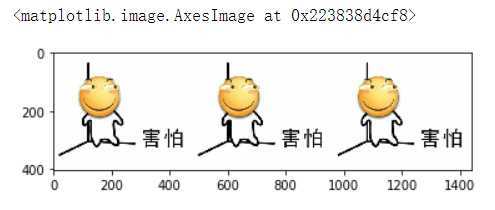
img_arr_9 = np.concatenate((img_arr_3,img_arr_3,img_arr_3),axis=0) #三张横向拼接的图 再三张纵向拼接
plt.imshow(img_arr_9)
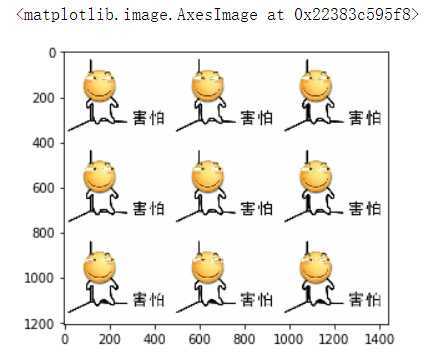
常用的聚合操作
- sum,max,min,mean
arr.sum() #arr 内所有元素的和
1525
arr.sum(axis=0) #所有行的和
array([309, 303, 175, 175, 267, 296]) #sum 、 max 、 min 差不多
arr.mean(axis=0) #求所有行的均值
array([45.8, 73.2, 48.6, 50.6, 47.4, 41.8])
array([33.4, 51.3, 66.9])
常用的数学函数
- NumPy 提供了标准的三角函数:sin()、cos()、tan()
- numpy.around(a,decimals) 函数返回指定数字的四舍五入值。
- 参数说明:
- a: 数组
- decimals: 舍入的小数位数。 默认值为0。 如果为负,整数将四舍五入到小数点左侧的位置
- 参数说明:
np.sin([3,5,4,6,2,1]) # 数转正弦函数
array([ 0.14112001, -0.95892427, -0.7568025 , -0.2794155 , 0.90929743,
0.84147098])
np.around([33.4,51.2,66.8],decimals=-1) #四舍五入 decimals 0 表示保留整数 -1 表示小数点外第一个数做四舍五入 即33.4的个位数3 51.6的1 做四舍五入 1 表示的是小数点最后一位做
四舍五入
array([30., 50., 70.])
np.around([33.44,51.26,66.86],decimals=1)
常用的统计函数
- numpy.amin() 和 numpy.amax(),用于计算数组中的元素沿指定轴的最小、最大值。
- numpy.ptp():计算数组中元素最大值与最小值的差(最大值 - 最小值)。
- numpy.median() 函数用于计算数组 a 中元素的中位数(中值)
- 标准差std():标准差是一组数据平均值分散程度的一种度量。
- 公式:std = sqrt(mean((x - x.mean())**2))
- 如果数组是 [1,2,3,4],则其平均值为 2.5。 因此,差的平方是 [2.25,0.25,0.25,2.25],并且其平均值的平方根除以 4,即 sqrt(5/4) ,结果为 1.1180339887498949。
- 方差var():统计中的方差(样本方差)是每个样本值与全体样本值的平均数之差的平方值的平均数,即 mean((x - x.mean())** 2)。换句话说,标准差是方差的平方根。
np.median(arr,axis=0) #求出中位数
array([30., 80., 57., 42., 57., 37.])
#标准差
arr.std(axis=1)
array([38.74453366, 28.38867145, 35.87787929, 26.04963212, 27.66867463])
矩阵相关
- NumPy 中包含了一个矩阵库 numpy.matlib,该模块中的函数返回的是一个矩阵,而不是 ndarray 对象。一个 的矩阵是一个由行(row)列(column)元素排列成的矩形阵列。
- numpy.matlib.identity() 函数返回给定大小的单位矩阵。单位矩阵是个方阵,从左上角到右下角的对角线(称为主对角线)上的元素均为 1,除此以外全都为 0。
转置矩阵
.T
arr.T #行变列,列变行
array([[14, 30, 4, 83, 98],
[89, 98, 80, 75, 24],
[71, 10, 6, 99, 57],
[96, 64, 27, 24, 42],
[ 1, 71, 88, 57, 20],
[94, 54, 3, 37, 21]])
矩阵相乘
- numpy.dot(a, b, out=None)
- a : ndarray 数组
- b : ndarray 数组
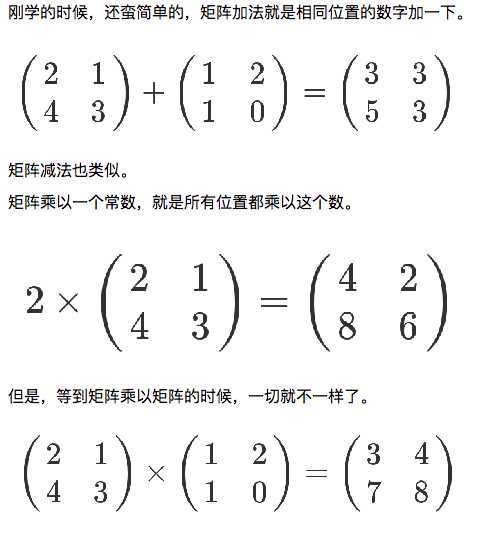
np.dot([[2,1],[4,3]],[[1,2],[1,0]])
array([[3, 4], [7, 8]])
pandas
为什么学习pandas
- numpy已经可以帮助我们进行数据的处理了,那么学习pandas的目的是什么呢?
- numpy能够帮助我们处理的是数值型的数据,当然在数据分析中除了数值型的数据还有好多其他类型的数据(字符串,时间序列),那么pandas就可以帮我们很好的处理除了数值型的其他数据!
什么是pandas?
- 首先先来认识pandas中的两个常用的类
- Series
- DataFrame
Series
- Series是一种类似与一维数组的对象,由下面两个部分组成:
- values:一组数据(ndarray类型)
- index:相关的数据索引标签
- Series的创建
- 由列表或numpy数组创建
- 由字典创建
Series的索引
- 隐式索引:默认形式的索引(0,1,2....)
- 显示索引:自定义的索引,可以通过index参数设置显示索引
import pandas as pd from pandas import Series,DataFrame import numpy as np
Series(data=[1,2,3,4,5]) #data是数据源 可以是列表 也可以是字典
索引 值
0 1 1 2 2 3 3 4 4 5 dtype: int64
dic = {
‘A‘:100,
‘B‘:99,
‘C‘:120
}
Series(data=dic)
A 100 B 99 C 120 dtype: int64
Series(data=np.random.randint(0,100,size=(3,)),index=[‘A‘,‘B‘,‘C‘])
Series的索引和切片
s = Series(data=np.linspace(0,30,num=5),index=[‘a‘,‘b‘,‘c‘,‘d‘,‘e‘]) s
a 0.0 b 7.5 c 15.0 d 22.5 e 30.0 dtype: float64
s[1] #通过索引
s[‘c‘] #通过显示索引 显示索引也可以用点的方式点出来
s.c
s[0:3] #切片
s[‘a‘:‘d‘] #通过索引切片
a 0.0 b 7.5 c 15.0 d 22.5 dtype: float64
Series的常用属性
- shape 形状
- size 大小
- index 索引 (有显示索引是显示 没有 就隐式索引)
- values 值
s.index
s.values
array([ 0. , 7.5, 15. , 22.5, 30. ])
- Series的常用方法
- head(),tail()
- unique()
- isnull(),notnull()
- add() sub() mul() div()
#显示Series的前n个或者后n个元素 s.head(3) # 只显示前三个 默认是5
s.tail(2) # 只显示后两个
d 22.5 e 30.0 dtype: float64
s = Series(data=[1,1,2,2,3,3,3,3,3,3,4,5,6,7,7,7])
s.unique() #去除重复元素
array([1, 2, 3, 4, 5, 6, 7])
s.nunique() #统计去重后的元素个数
7
Series的算术运算
- 法则:索引一致的元素进行算数运算否则补空
s1 = Series(data=[1,2,3,4,5],index=[‘a‘,‘b‘,‘c‘,‘d‘,‘e‘]) s2 = Series(data=[1,2,3,4,5],index=[‘a‘,‘b‘,‘f‘,‘d‘,‘e‘]) s = s1 + s2 s 索引不一样的无法+ 补空 显示NaN
a 2.0 b 4.0 c NaN d 8.0 e 10.0 f NaN dtype: float64
s.isnull() #检测Series哪些元素为空,为空则返回True,否则返回False
a False b False c True d False e False f True dtype: bool
s.notnull() #哪些元素为非空,返回True,否则返回False
a True b True c False d True e True f False dtype: bool
s
a 2.0 b 4.0 c NaN d 8.0 e 10.0 f NaN dtype: float64
#想要将s中的非空的数据取出
s[[True,True,False,True,True,False]]
a 2.0 b 4.0 d 8.0 e 10.0 dtype: float64
s[s.notnull()] #可以对Series中的空值进行清洗
a 2.0 b 4.0 d 8.0 e 10.0 dtype: float64
DataFrame
- DataFrame是一个【表格型】的数据结构。DataFrame由按一定顺序排列的多列数据组成。设计初衷是将Series的使用场景从一维拓展到多维。DataFrame既有行索引,也有列索引。
- 行索引:index
- 列索引:columns
- 值:values
- DataFrame的创建
- ndarray创建
- 字典创建
df = DataFrame(data=np.random.randint(0,100,size=(5,6)),columns=[‘a‘,‘b‘,‘c‘,‘d‘,‘e‘,‘f‘],index=[‘A‘,‘B‘,‘C‘,‘D‘,‘E‘])
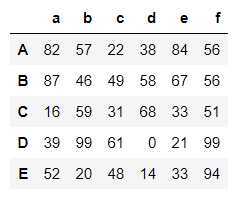
dic = {
‘name‘:[‘jay‘,‘tom‘,‘bobo‘],
‘salary‘:[10000,20000,30000]
}
DataFrame(data=dic,index=[‘a‘,‘b‘,‘c‘])
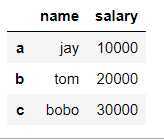
DataFrame的属性
- values、columns、index、shape
df.values #返回元素 df.columns #列索引 df.index #行索引 df.shape #形状
DataFrame索引操作- 对行进行索引
- 队列进行索引
- 对元素进行索引
df
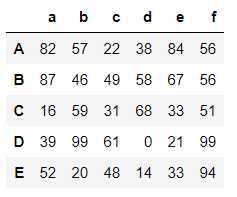
#对列进行索引(只可以使用显示列索引)
df[‘a‘]
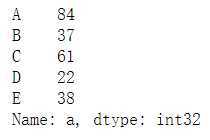
df[[‘a‘,‘b‘]] #取多列
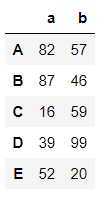
- iloc:
- 通过隐式索引取行
- loc:
- 通过显示索引取行
#索引取行 df.loc[‘B‘] #显示索引 df.iloc[1] #隐式索引
#取出多行 df.iloc[[1,2,3]]
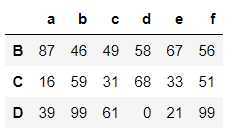
#取出元素
df.loc[‘B‘,‘e‘]
67
#取多个元素
df.iloc[[1,2],3] # 取出 2 3 两行 第三列的元素

DataFrame的切片操作
- 对行进行切片
- 对列进行切片
df
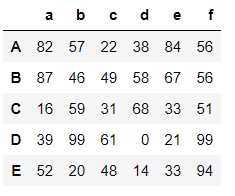
#切行 df[0:3]
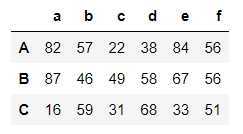
#切列
df.iloc[:,0:3]
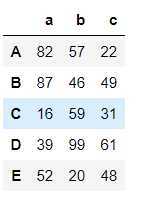
- df索引和切片操作
- 索引:
- df[col]:取列
- df.loc[index]:取行
- df.iloc[index,col]:取元素
- 切片:
- df[index1:index3]:切行
- df.iloc[:,col1:col3]:切列
- 索引:
- DataFrame的运算
- 同Series
============================================
练习4:
根据以下考试成绩表,创建一个DataFrame,命名为df:
张三 李四
语文 100 0
数学 90 0
英语 90 0
理综 100 0-
假设ddd是期中考试成绩,ddd2是期末考试成绩,请自由创建ddd2,并将其与ddd相加,求期中期末平均值。
-
假设张三期中考试数学被发现作弊,要记为0分,如何实现?
-
李四因为举报张三作弊立功,期中考试所有科目加100分,如何实现?
-
后来老师发现有一道题出错了,为了安抚学生情绪,给每位学生每个科目都加10分,如何实现?
============================================
dic = { ‘张三‘:[100,90,90,100], ‘李四‘:[0,0,0,0] } df = DataFrame(data=dic,index=[‘语文‘,‘数学‘,‘英语‘,‘理综‘]) qizhong = df qimo = df
(qizhong + qimo) / 2 #平均成绩
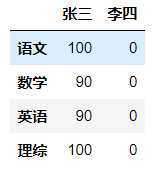
#假设张三期中考试数学被发现作弊,要记为0分,如何实现
qizhong.loc[‘数学‘,‘张三‘] = 0
qizhong
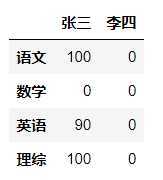
#李四因为举报张三作弊立功,期中考试所有科目加100分,如何实现
qizhong[‘李四‘] += 100
qizhong
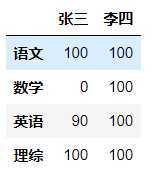
#给每位学生每个科目都加10分
qizhong += 10
qizhong
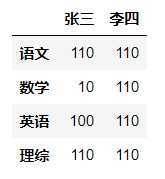
- 时间数据类型的转换
- pd.to_datetime(col)
- 将某一列设置为行索引
- df.set_index()
dic = { ‘name‘:[‘jay‘,‘tom‘,‘bobo‘], ‘hire_date‘:[‘2010-10-11‘,‘2012-12-01‘,‘2011-11-12‘], ‘salary‘:[10000,20000,30000] } df = DataFrame(data=dic) df
#info返回df的基本信息
df.info()
<class ‘pandas.core.frame.DataFrame‘> RangeIndex: 3 entries, 0 to 2 Data columns (total 3 columns): name 3 non-null object #在数据分析中 字符串 可以是 object 也可是 str hire_date 3 non-null object salary 3 non-null int64 dtypes: int64(1), object(2) memory usage: 152.0+ bytes
#想要将字符串形式的时间数据转换成时间序列类型
df[‘hire_date‘] = pd.to_datetime(df[‘hire_date‘])
df.info()
<class ‘pandas.core.frame.DataFrame‘> RangeIndex: 3 entries, 0 to 2 Data columns (total 3 columns): name 3 non-null object hire_date 3 non-null datetime64[ns] ------------------------------------------------->字符串类型变成了时间序列类型 salary 3 non-null int64 dtypes: datetime64[ns](1), int64(1), object(1) memory usage: 152.0+ bytes
#想要将hire_date列作为源数据的行索引
new_df = df.set_index(‘hire_date‘)
new_df

new_df.shape
(3, 2) ------------------------>由于 原来的hire_date 变成了索引 现在 就只要三行两列了
DataFrame基础操作巩固-股票分析
tushare财经数据接口包
- pip install tushare
- 作用:提供相关指定的财经数据
需求:股票分析
- 使用tushare包获取某股票的历史行情数据。
- 输出该股票所有收盘比开盘上涨3%以上的日期。
- 输出该股票所有开盘比前日收盘跌幅超过2%的日期。
- 假如我从2010年1月1日开始,每月第一个交易日买入1手股票,每年最后一个交易日卖出所有股票,到今天为止,我的收益如何?
import tushare as ts import pandas as pd from pandas import Series,DataFrame import numpy as np
#使用tushare包获取某股票的历史行情数据。
df = ts.get_k_data(code=‘600519‘,start=‘1999-01-10‘)
df
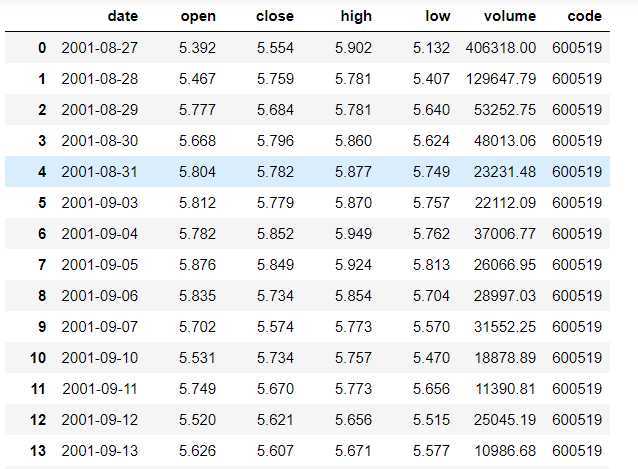 (太多了 只截一部分)
(太多了 只截一部分)
df的持久化存储
- df.to_xxx()
#将df的数据存储到本地 df.to_csv(‘./maotai.csv‘)
#加载外部数据到df中:read_xxx() df = pd.read_csv(‘./maotai.csv‘) df.head()
#将Unnamed: 0列进行删除 #在drop系列的函数中axis=0表示的行,1表示的是列 df.drop(labels=‘Unnamed: 0‘,axis=1,inplace=True)
#查看数据的原始信息
df.info()
<class ‘pandas.core.frame.DataFrame‘> RangeIndex: 4503 entries, 0 to 4502 Data columns (total 7 columns): date 4503 non-null object open 4503 non-null float64 close 4503 non-null float64 high 4503 non-null float64 low 4503 non-null float64 volume 4503 non-null float64 code 4503 non-null int64 dtypes: float64(5), int64(1), object(1) memory usage: 246.3+ KB
#将date列的字符串类型的时间转换成时间序列类型
df[‘date‘] = pd.to_datetime(df[‘date‘])
df[‘date‘].dtype
dtype(‘<M8[ns]‘)
#将date列作为源数据的行索引
df.set_index(keys=‘date‘,inplace=True)
#输出该股票所有收盘比开盘上涨3%以上的日期。
#(收盘-开盘)/开盘 > 0.03
(df[‘close‘] - df[‘open‘]) / df[‘open‘] > 0.03
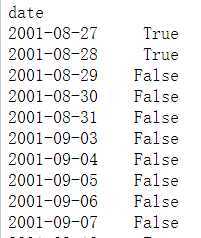 ]
]
#经验:在df的相关操作中如果一旦返回了布尔值,下一步马上将布尔值作为原始数据的行索引
#发现布尔值可以作为df的行索引,可以直接取出true对应的行数据 df.loc[[True,True,False,False,True]]

#将满足需求的行数据获取(收盘比开盘上涨3%以上) df.loc[(df[‘close‘] - df[‘open‘]) / df[‘open‘] > 0.03]
#获取满足要求的日期 df.loc[(df[‘close‘] - df[‘open‘]) / df[‘open‘] > 0.03].index DatetimeIndex([‘2001-08-27‘, ‘2001-08-28‘, ‘2001-09-10‘, ‘2001-12-21‘, ‘2002-01-18‘, ‘2002-01-31‘, ‘2003-01-14‘, ‘2003-10-29‘, ‘2004-01-05‘, ‘2004-01-14‘, ... ‘2020-03-02‘, ‘2020-03-05‘, ‘2020-03-10‘, ‘2020-04-02‘, ‘2020-04-22‘, ‘2020-05-06‘, ‘2020-05-18‘, ‘2020-07-02‘, ‘2020-07-06‘, ‘2020-07-07‘], dtype=‘datetime64[ns]‘, name=‘date‘, length=314, freq=None)
#输出该股票所有开盘比前日收盘跌幅超过2%的日期。 #(开盘 - 前日收盘) / 前日收盘 < -0.02 (df[‘open‘] - df[‘close‘].shift(1)) / df[‘close‘].shift(1) < -0.02 df.loc[(df[‘open‘] - df[‘close‘].shift(1)) / df[‘close‘].shift(1) < -0.02] df.loc[(df[‘open‘] - df[‘close‘].shift(1)) / df[‘close‘].shift(1) < -0.02].index
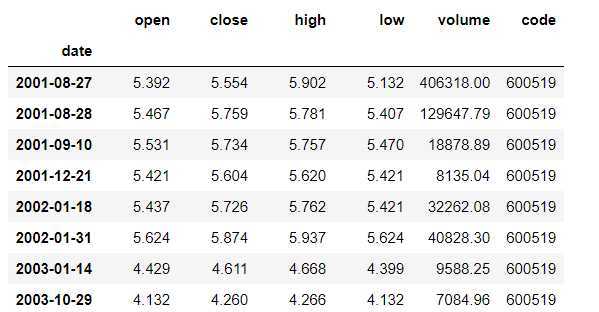
假如我从2010年1月1日开始,每月第一个交易日买入1手(100支)股票,每年最后一个交易日卖出所有股票,到今天为止,我的收益如何?
- 买股票
- 每月的第一个交易日根据开盘价买入一手股票
- 一个完整的年需要买入12次12手1200支股票
- 卖股票
- 每年最后一个交易日根据开盘价(12-31)卖出所有的股票
- 一个完整的年需要卖出1200支股票
- 注意:2020年这个人只能买入700支股票,无法卖出。但是在计算总收益的时候需要将剩余股票的价值也计算在内
- 剩余股票价值如何计算:
- 700 * 买入当日的开盘价
- 剩余股票价值如何计算:
new_df = df[‘2010‘:‘2020‘] #如果行索引为时间序列类型数据
#数据的重新取样resample df_monthly = new_df.resample(rule=‘M‘).first() df_monthly#每一个月第一个交易日对应的行数据
#计算买入股票一共花了多少钱 cost = df_monthly[‘open‘].sum() * 100 cost 4636917.100000001
#求出卖出股票收入多少钱:A表示的是年 df_yearly = new_df.resample(‘A‘).last()[0:-1] df_yearly#存储的是每一年最后一个交易日对应的行数据
recv = df_yearly[‘open‘].sum() * 1200 recv 4368184.8
#求出剩余股票的价值 last = 700 * df[‘open‘][-1]
#总收益 recv + last - cost
913567.6999999993
需求:双均线策略制定
- 使用tushare包获取某股票的历史行情数据
计算该股票历史数据的5日均线和30日均线- 什么是均线?
- 对于每一个交易日,都可以计算出前N天的移动平均值,然后把这些移动平均值连起来,成为一条线,就叫做N日移动平均线。移动平均线常用线有5天、10天、30天、60天、120天和240天的指标。
- 5天和10天的是短线操作的参照指标,称做日均线指标;
- 30天和60天的是中期均线指标,称做季均线指标;
- 120天和240天的是长期均线指标,称做年均线指标。
- 对于每一个交易日,都可以计算出前N天的移动平均值,然后把这些移动平均值连起来,成为一条线,就叫做N日移动平均线。移动平均线常用线有5天、10天、30天、60天、120天和240天的指标。
- 均线计算方法:MA=(C1+C2+C3+...+Cn)/N C:某日收盘价 N:移动平均周期(天数)
分析输出所有金叉日期和死叉日期- 股票分析技术中的金叉和死叉,可以简单解释为:
- 分析指标中的两根线,一根为短时间内的指标线,另一根为较长时间的指标线。
- 如果短时间的指标线方向拐头向上,并且穿过了较长时间的指标线,这种状态叫“金叉”;
- 如果短时间的指标线方向拐头向下,并且穿过了较长时间的指标线,这种状态叫“死叉”;
- 一般情况下,出现金叉后,操作趋向买入;死叉则趋向卖出。当然,金叉和死叉只是分析指标之一,要和其他很多指标配合使用,才能增加操作的准确性。
- 如果我从假如我从2010年1月1日开始,初始资金为100000元,金叉尽量买入,死叉全部卖出,则到今天为止,我的炒股收益率如何?
- 分析:
- 买卖股票的单价使用开盘价
- 买卖股票的时机
- 最终手里会有剩余的股票没有卖出去
- 会有。如果最后一天为金叉,则买入股票。估量剩余股票的价值计算到总收益。
- 剩余股票的单价就是用最后一天的收盘价。
- 会有。如果最后一天为金叉,则买入股票。估量剩余股票的价值计算到总收益。
?
原文:https://www.cnblogs.com/linranran/p/13296374.html

